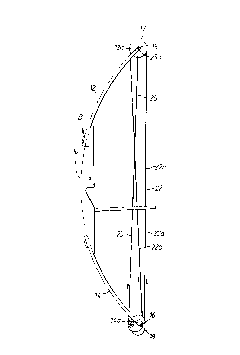Some of the information on this Web page has been provided by external sources. The Government of Canada is not responsible for the accuracy, reliability or currency of the information supplied by external sources. Users wishing to rely upon this information should consult directly with the source of the information. Content provided by external sources is not subject to official languages, privacy and accessibility requirements.
Any discrepancies in the text and image of the Claims and Abstract are due to differing posting times. Text of the Claims and Abstract are posted:
| (12) Patent: | (11) CA 2089799 |
|---|---|
| (54) English Title: | DUAL-FEED SINGLE-CAM COMPOUND BOW |
| (54) French Title: | ARC A POULIES A ALIMENTATION DOUBLE ET A CAME UNIQUE |
| Status: | Term Expired - Post Grant Beyond Limit |
| (51) International Patent Classification (IPC): |
|
|---|---|
| (72) Inventors : |
|
| (73) Owners : |
|
| (71) Applicants : |
|
| (74) Agent: | AVENTUM IP LAW LLP |
| (74) Associate agent: | |
| (45) Issued: | 1999-02-16 |
| (22) Filed Date: | 1993-02-18 |
| (41) Open to Public Inspection: | 1993-10-29 |
| Examination requested: | 1994-03-23 |
| Availability of licence: | N/A |
| Dedicated to the Public: | N/A |
| (25) Language of filing: | English |
| Patent Cooperation Treaty (PCT): | No |
|---|
| (30) Application Priority Data: | ||||||
|---|---|---|---|---|---|---|
|
A dual-feed single-cam compound bow
construction which eliminates one of the let-off cams
from a conventional compound bow by providing a
dual-feed single cam with an opposed concentric pulley
whereby the increment of feed-out caused by the drawing
of the bow is balanced against the increment of take-up
so that the same amount of cable is fed to both ends of
the bowstring during the drawing operation. This is
accomplished by designing the respective radii of the
cam and pulley grooves to balance the rate of feed-out
of both feed-out sections of cable from the let-off cam.
Arc à poulie à came unique et à alimentation double, dans laquelle les deux cames de déroulement de l'arc à poulie classique sont remplacées par une came unique à alimentation double et une poulie concentrique placée en face de la came, mécanisme grâce auquel, lorsque l'on bande l'arc, une longueur équivalente de corde est déroulée ou enroulée de sorte que la même longueur de corde arrive à chaque bout de l'arc. Cet équilibre est assuré en choisissant les rayons respectifs des rainures de la came et de la poulie de façon à équilibrer le taux de déroulement des deux dévidoirs de la came.
Note: Claims are shown in the official language in which they were submitted.
Note: Descriptions are shown in the official language in which they were submitted.

2024-08-01:As part of the Next Generation Patents (NGP) transition, the Canadian Patents Database (CPD) now contains a more detailed Event History, which replicates the Event Log of our new back-office solution.
Please note that "Inactive:" events refers to events no longer in use in our new back-office solution.
For a clearer understanding of the status of the application/patent presented on this page, the site Disclaimer , as well as the definitions for Patent , Event History , Maintenance Fee and Payment History should be consulted.
| Description | Date |
|---|---|
| Inactive: Adhoc Request Documented | 2018-06-06 |
| Revocation of Agent Requirements Determined Compliant | 2018-05-18 |
| Appointment of Agent Requirements Determined Compliant | 2018-05-18 |
| Inactive: Expired (new Act pat) | 2013-02-18 |
| Letter Sent | 2003-11-26 |
| Letter Sent | 2003-11-26 |
| Letter Sent | 2003-04-02 |
| Letter Sent | 2003-04-02 |
| Inactive: Correspondence - Transfer | 2003-02-03 |
| Inactive: Office letter | 2002-12-02 |
| Inactive: Multiple transfers | 2002-09-26 |
| Inactive: Prior art correction | 1999-07-09 |
| Grant by Issuance | 1999-02-16 |
| Inactive: Office letter | 1999-01-08 |
| Letter Sent | 1998-06-12 |
| Notice of Allowance is Issued | 1998-06-12 |
| Notice of Allowance is Issued | 1998-06-12 |
| Inactive: Application prosecuted on TS as of Log entry date | 1998-06-05 |
| Inactive: Status info is complete as of Log entry date | 1998-06-05 |
| Inactive: First IPC assigned | 1998-03-20 |
| Inactive: IPC removed | 1998-03-20 |
| Inactive: IPC assigned | 1998-03-20 |
| Inactive: Approved for allowance (AFA) | 1998-03-17 |
| Pre-grant | 1996-11-18 |
| All Requirements for Examination Determined Compliant | 1994-03-23 |
| Request for Examination Requirements Determined Compliant | 1994-03-23 |
| Application Published (Open to Public Inspection) | 1993-10-29 |
There is no abandonment history.
The last payment was received on 1998-02-13
Note : If the full payment has not been received on or before the date indicated, a further fee may be required which may be one of the following
Please refer to the CIPO Patent Fees web page to see all current fee amounts.
Note: Records showing the ownership history in alphabetical order.
| Current Owners on Record |
|---|
| BEAR ARCHERY, INC. |
| Past Owners on Record |
|---|
| MATHEW MCPHERSON |